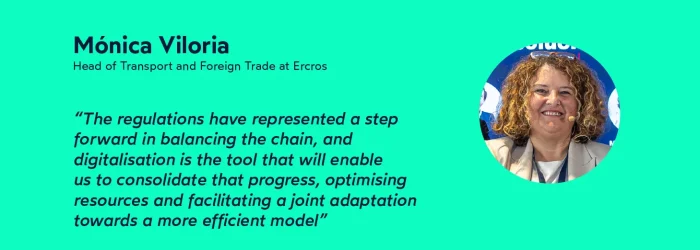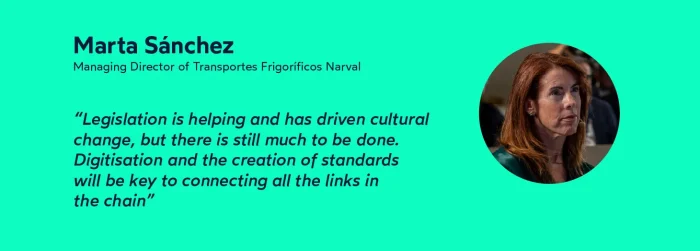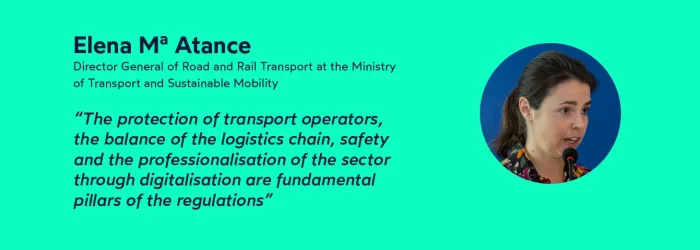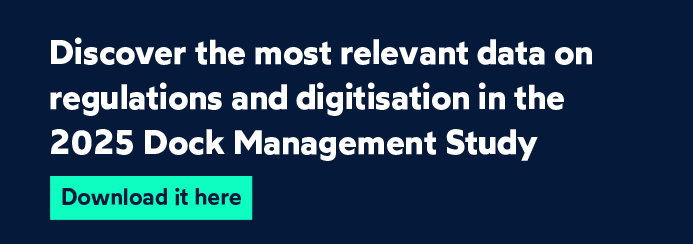One dock, two realities, one solution: dock digitization


During the presentation event of the study “Dock Management in Spain three years after RDL 3/2022: degree of digitization and perspectives of shippers and carriers”, a discussion panel took place dedicated to the digitization of docks, among other issues.
Under the name “One dock, two realities, one solution: digitization”, this round table discussion served to get the perspective of loading and transport companies on the regulation and its impact, the digitization of docks, the main challenges for each of the actors and the future prospects.
Beyond the presentation of the data from the Docks 2025 Study, the objective of the event was to generate a live, constructive debate on the weakest points of this link in the supply chain, in order to analyze them and find efficient solutions in a collaborative manner.
Thus, under the moderation of Ramón García, General Director of the Spanish Logistics Center (CEL), the discussion table was made up of two shipping companies (Galletas Gullón and Ercros), two transport companies (Carreras Grupo Logístico and Transportes Frigoríficos Narval), and FIELDEAS, as representative of the technology companies with solutions for dock management.

One of the main conclusions of the study is that digitization is the driving lever to improve efficiency in dock management.
Therefore, although shippers and carriers live two different realities on the same dock, the solution to solve the challenges for both parties is the implementation of solutions such as the Yard Management System (YMS).
The first part of the round table was devoted to the impact of RDL 3/2022 on both agents and the opinion of each speaker on this regulation three years after its entry into force.
In this sense, and in line with the results of the study, all the speakers agreed that the entry into force of RDL 3/2022 has meant a significant advance in the organization of the sector, providing order and clear rules in the relationship between shippers and carriers.

It was also recognized that the standard has brought about a cultural change, as it has contributed to balancing the chain and protecting the driver, especially when loading and unloading.
However, they also pointed out that there is still some way to go, arguing that the law has set the general framework, but there is a lack of adjustments and developments that address existing gaps and respond in more detail to the operational reality of the sector.
In short, the regulation was seen as a solid starting point that has fostered a cultural change and opened the door to future improvements.
In this section it was pointed out that, although the regulations have served to make productivity problems visible, they have not resolved the structural imbalances in day-to-day operations.
Thus, the speakers agreed that efficiency in dock management remains a challenge, especially in loading and unloading times, more aggravated at the unloading points of end customers.
According to the study, 69.23% of carriers and 53.50% of shippers indicate that their waiting times exceed the legally permitted time.

Also on the table was the need to improve planning and coordination among the different actors, in order to minimize delays and optimize available resources.
As a proposal to boost productivity, the importance of attracting and retaining talent in a context of driver shortage, and of offering higher value-added jobs to ensure the sustainability of the sector was stressed.
In short, the operational organization needs to evolve towards a more agile, balanced model focused on real efficiency.
Digitalization was identified as the key tool for the transformation of the logistics sector.
This is also reflected in the study, where despite finding significant challenges around digitization, both shippers (55.81%) and carriers (43.59%) agree that digitization and automation are priority measures to improve efficiency.

Along these lines, the participants agreed that the adoption of digital solutions makes it possible to optimize resources, improve traceability and bring transparency to processes.
However, important challenges were also recognized:
With these challenges on the table, the need to move towards interoperability and data homogenization was stressed, so that all parties (shippers, carriers and operators, and even customers) work on connected systems that provide shared value.
Digitalization is therefore understood not only as a technological advance, but also as a cultural change that requires collaboration, a common vision and clear standards.
Another key point of both the study and the roundtable discussion was the traditionally strained relationship between shippers and carriers.
Although the study concludes that the regulations have not led to a substantial improvement in relations, it does detect a cultural change in favor of collaboration and information sharing.

During the roundtable, each agent was asked what it needs from the other to improve dock management. The participants pointed out that improving the process requires more precise planning, greater availability of resources and fluid communication between the different links in the chain.
In the same vein, the need to make effective use of available digital tools and to promote direct coordination between those who manage transportation and those who operate on the docks was highlighted.
In addition, it became clear that transportation is a limited resource and that its optimization requires a joint vision of all parties involved.
Therefore, the key is to turn the shipper-carrier relationship into an active collaboration based on information and mutual trust.
At this point, the question was raised as to how far the digitization of docks can go.
In this sense, the closing of the round table focused on the potential of digitization as an axis of collaboration and continuous improvement.

It was emphasized that the regulation provides a framework of reference, but that true optimization will be achieved when the companies will concretize their relationships in contracts with measurable indicators (KPIs) that allow the evaluation of compliance and efficiency of the processes.
Under this premise, technology is presented as the means to measure, analyze and improve, provided that there is interoperability between platforms and commitment on the part of all stakeholders.
Therefore, it was concluded that the future of the sector lies in combining regulatory framework, collaboration and technology, with digitalization being the element that will transform logistics management into a more transparent, efficient and sustainable system.

For her part, Elena Mª Atance, Director General of Road and Rail Transport of the Ministry of Transport and Sustainable Mobility, reinforced this message during the institutional closing, stressing the need to reduce the digital divide, professionalize the sector and move towards the obligatory use of electronic documents as a fundamental step towards modern and collaborative logistics.


10 Dec 2024
YMS software: Active involvement of the driver in dock management

29 Apr 2025
How to eliminate blind spots in your inbound logistics with a YMS system

20 May 2025
How a YMS solution with real-time technology improves dock management

01 Oct 2025
Dock Management 2025 Study: 51.16% of shippers already have technological solutions in place